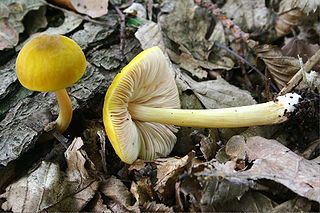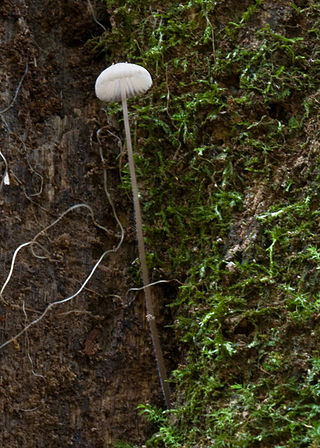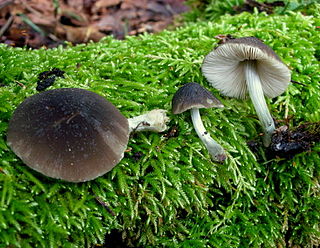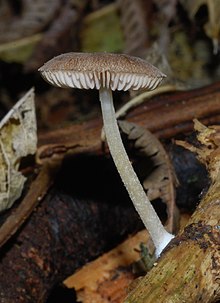
Pluteus cervinus, commonly known as the deer shield, deer mushroom, or fawn mushroom, is a species of fungus in the order Agaricales. Fruit bodies are agaricoid (mushroom-shaped). Pluteus cervinus is saprotrophic and fruit bodies are found on rotten logs, roots, tree stumps, sawdust, and other wood waste. The species is common in Europe and eastern North America, but rare and possibly introduced in western North America.

Pluteus is a large genus of fungi with over 300 species. They are wood rotting saprobes with pink spore prints and gills that are free from the stem.

Pluteus salicinus is a European psychedelic mushroom that grows on wood. It is an edible mushroom after parboiling.

Pluteus leoninus, commonly known as lion shield, can occasionally be found growing on dead wood in Europe and North Africa. The underside of the cap is typical of the genus Pluteus — the gills are pale, soon becoming pink when the spores ripen. But the upper surface is a bright tawny or olivaceous yellow. The species name leoninus refers to this cap colour.

Entoloma hochstetteri, also known as the blue pinkgill, sky-blue mushroom or similar names, is a species of mushroom that is native to New Zealand. The small mushroom is a distinctive all-blue colour, while the gills have a slight reddish tint from the spores. The blue colouring of the fruit body is due to azulene pigments. Whether Entoloma hochstetteri is poisonous or not is unknown.

Cortinarius rotundisporus, also known as the elegant blue webcap, is a basidiomycete mushroom of the genus Cortinarius found in southern Australia, where it is found in eucalypt forests and rainforests. The cap of the fruit body is a steely blue colour, with a yellowish boss, and paler similarly coloured stipe.

Amanita australis is a species of fungus in the family Amanitaceae. It produces small- to medium-sized fruit bodies, with brown caps up to 9 centimetres in diameter covered with pyramidal warts. The gills on the underside of the cap are white, closely crowded together, and free from attachment to the stem. The stem, up to 9 cm long, has a ring and a bulbous base. The mushroom may be confused with another endemic New Zealand species, A. nothofagi, but can be distinguished by differences in microscopic characteristics.

Amanita nothofagi is a species of fungus in the family Amanitaceae. Endemic to New Zealand, the species was first described by mycologist Greta Stevenson in 1962. The fruit bodies have dark brown caps that are up to 13 cm (5.1 in) in diameter and covered with patches of soft greyish-brown scales or warts. The gills underneath the cap are crowded together, free from attachment to the stem, and white, becoming tinged with yellow in age. The stem of the mushroom is 4–14 cm (1.6–5.5 in) long by 0.5–2.5 cm (0.2–1.0 in) thick, and has a ring. The spore print is white, and individual spores are spherical to ellipsoid, measuring 7.5–9 by 7.5–9 micrometres. The mushroom may be confused with another New Zealand species, A. australis, but can be distinguished by certain characteristics. Amanita nothofagi is a mycorrhizal species, and grows in association with native New Zealand trees such as Southern Beech.

Agaricus hondensis, commonly known as the felt-ringed agaricus, is a species of fungus in the family Agaricaceae. The species was officially described in 1912 by mycologist William Alphonso Murrill, along with three other Agaricus species that have since been placed in synonymy with A. hondensis. Found in the Pacific Northwest region of North America, A. hondensis fruits in the fall under conifers or in mixed forests.

Mycena cystidiosa is a species of mushroom in the family Mycenaceae. Described as new to science in 1964, it is known only from New Zealand and Australia. The fruit bodies have a broadly conical small white cap up to 12 mm (0.5 in) wide, with distantly spaced cream-coloured gills on the underside. The stipe is particularly long, up to 20 cm (8 in), with an abundant covering of white hairs at the base. The species is known for its abundant rhizomorphs—long, root-like extensions of mycelia.

Roridomyces austrororidus, commonly known as the austro dripping bonnet, is a species of agaric fungus in the family Mycenaceae. Described as new to science in 1962 by American mycologist Rolf Singer, it is found in South America, New Zealand, and Australia, where it grows on rotting wood.

Pluteus phaeocyanopus is an agaric fungus in the family Pluteaceae. Described as a new species in 2010, it has only been collected from California, where it grows singularly or in groups on the decaying wood of oak. The fruit body has a smooth brown cap measuring 2–4 cm (0.8–1.6 in) in diameter. The stipe is 2–5 cm (0.8–2.0 in) long by 0.4–0.8 cm (0.16–0.31 in) thick, and roughly equal in width throughout. It is whitish but becomes grayish-green near the base. The thin and fragile gills are free from attachment to the stipe, close to somewhat distantly placed, and interspersed with several tiers of lamellulae. The flesh has no distinctive taste or odor. The spores are spherical or nearly so and measure 6.2–8.4 by 5.7–7.9 μm.

Volvopluteus michiganensis is a species of mushroom in the family Pluteaceae. It was originally described under the name Pluteus michiganensis but molecular studies have placed it in the Volvopluteus, a genus described in 2011. The cap of this mushroom is about 7–9 cm (2.8–3.5 in) in diameter, gray, and has a cracked margin that is sticky when fresh. The gills start out as white but they soon turn pink. The stipe is white and has a volva at the base. Microscopical features and DNA sequence data are of great importance for separating this taxon from related species. V. michiganensis is a saprotrophic fungus that was originally described as growing on sawdust. It has only been reported from Michigan (US) and the Dominican Republic.

Harrya chromapes, commonly known as the yellowfoot bolete or the chrome-footed bolete, is a species of bolete fungus in the family Boletaceae. The bolete is found in eastern North America, Costa Rica, and eastern Asia, where it grows on the ground, in a mycorrhizal association with deciduous and coniferous trees. Fruit bodies have smooth, rose-pink caps that are initially convex before flattening out. The pores on the cap undersurface are white, aging to a pale pink as the spores mature. The thick stipe has fine pink or reddish dots (scabers), and is white to pinkish but with a bright yellow base. The mushrooms are edible but are popular with insects, and so they are often infested with maggots.

Boletus subluridellus is a species of bolete fungus in the family Boletaceae. Described as new to science in 1971 by American mycologists, the bolete is found in the eastern United States and Canada. It grows on the ground in coniferous and mixed forests in a mycorrhizal association with deciduous trees, especially oak. The fruit bodies (mushrooms) have orangish-red, broadly convex caps that are up to 10 cm (3.9 in) in diameter, with small, dark reddish pores on the underside. The pale yellow stipe measures 4–9 cm (1.6–3.5 in) long by 1.5–2.3 cm (0.6–0.9 in) thick. All parts of the fruit body will quickly stain blue when injured or touched.

Pluteus americanus is a North American and Russian psychedelic mushroom that grows on hardwoods.

Fistulinella nivea is a species of bolete fungus in the family Boletaceae found in New Zealand. First described by mycologist Greta Stevenson in 1962 as a species of Tylopilus, it was transferred to the genus Fistulinella by Rolf Singer. Stevenson originally discovered the bolete in 1955 at Tōtaranui, where it was growing under Nothofagus. Its fruitbody has a white cap with a diameter of up to 3 cm (1.2 in) atop a stipe measuring up 7 cm (2.8 in) long and 1–1.5 cm (0.4–0.6 in) thick. The pores on the cap underside are up to 1.5 mm in diameter. The pore surface is initially white before changing to pale pink. Spores are ellipsoid, hyaline (translucent), and measure 17–18 by 6–7 µm.

Pluteus exilis is a species of agaric fungus in the family Pluteaceae. It was described as new to science by mycologist Rolf Singer in 1989, from specimens collected in Muir Woods, California.
Amanita subpallidorosea is a mushroom of the large genus Amanita, which occurs under oaks in southern China and Taiwan.

Pluteus microspermus is a saprotrophic, mushroom-like (agaricoid) fungi in the Section Pluteus. It is often confused with Pluteus concentricus, a species endemic to New Zealand because P. concentricus also has concentric ridges on its cap (pileus). P. microspermus and P. concentricus can be differentiated by microscopy as the spores are different sizes. P. concentricus also has rougher material on its stipe.



















